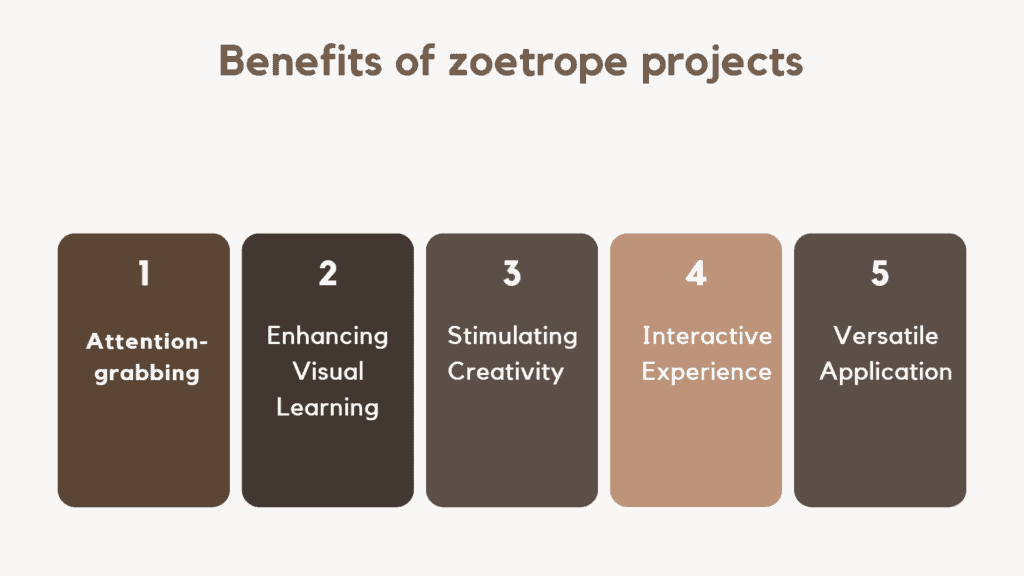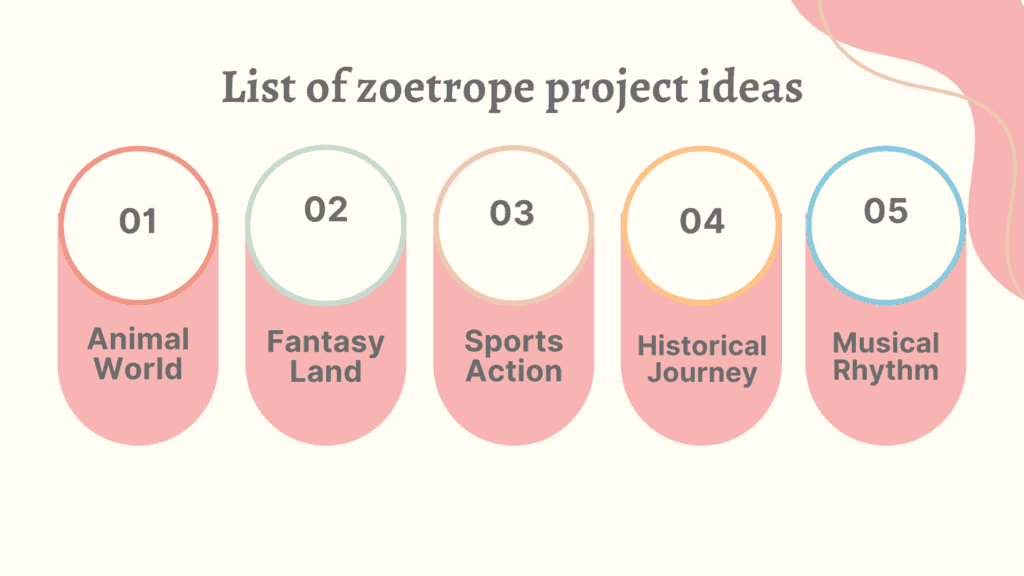Table of Contents
Key Takeaways
- The Zoetrope Project is a creative and engaging way to teach students about animation and storytelling.
- The project encourages students to think critically and problem-solve as they design and build their own zoetropes.
- The article provides several ideas for zoetrope projects, such as creating a zoetrope with a specific theme or story, or incorporating other materials like clay or paper cutouts.
- The project can be easily adapted for different age groups and skill levels, making it a versatile option for educators.
- The Zoetrope Project not only teaches students about animation, but also allows them to explore their creativity and express their ideas through a hands-on activity.
- By working on the project, students can develop important skills such as teamwork, communication, and perseverance.
- The article suggests incorporating a reflection component into the project, where students can discuss their process, challenges, and what they learned from the experience.
- The Zoetrope Project can be a great addition to a STEAM curriculum, as it combines elements of science, technology, engineering, art, and math.
- Educators can use the project as a starting point for further discussions on animation techniques, the history of animation, or even careers in the field.
- Overall, the Zoetrope Project offers a fun and educational way for students to explore animation and storytelling, while also developing important skills and knowledge.

The zoetrope – an enthralling blend of art and technology – has transfixed many through the ages. Let us explore project ideas involving zoetropes, showing their potential for creative expression.
Delve into the world of zoetropes! Unveil innovative project ideas and get inspired to begin your own artistic voyage. Learn how these captivating devices can animate static images, making them move with an illusion.
Build personalized zoetropes, with your own designs or pre-made templates. Experiment with different themes – like animals, nature, or fantasy worlds – and let your imagination go wild. This medium is flexible and allows for endless creativity, giving you the opportunity to express yourself.
Let sound add dynamism to your zoetrope projects. Think of pairing your animation with music or ambient sounds to give your viewers an immersive experience. This combination will add emotion and make your creations even more memorable.
Showcase your work! Share your captivating zoetrope animations with friends, family, and the artistic community. Use exhibitions, social media platforms, or online competitions to connect with other enthusiasts and receive valuable feedback.
Embrace this timeless art form and discover its potential for personal expression. Start brainstorming ideas for your zoetrope project now!
Brief history of zoetrope
The zoetrope? Fascinating! A precursor to modern animation, it has a captivating history. Invented in the early 19th century, it quickly rose in popularity. By spinning a cylinder with individual images inside, people could witness motion. This concept revolutionized visual storytelling, laying the foundation for future animation tech.
Uniquely, zoetropes transport viewers into different worlds and narratives. From ancient myths to city life scenes, these animated vignettes offer glimpses into human existence. Artists and inventors experiment with themes and characters.
Zoetropes weren’t only handheld; they were also incorporated into theatrical displays. Audiences were mesmerized by these moving images that seemed magical.
An interesting note: filmmakers still draw inspiration from this innovation, proving that even with progress, honoring our roots is essential for pushing artistic limits forward.
Benefits of zoetrope projects

Zoetrope projects are an amazing way to engage viewers, leaving them in awe. Here are five of their biggest benefits:
- Attention-grabbing: They capture attention with their mesmerizing motion, making them perfect for communication and storytelling.
- Enhancing Visual Learning: By rapidly presenting images, zoetropes can make complex concepts easier to understand.
- Stimulating Creativity: Making zoetropes requires imagination and ingenuity, encouraging problem-solving skills.
- Interactive Experience: Viewers actively participate in bringing the animations to life by spinning the device.
- Versatile Application: Zoetropes can be used in many fields like education, marketing, art, and entertainment.
Zoetropes have a long history, and their timeless appeal still captivates viewers today. Don’t miss the chance to use zoetropes in your endeavors. Unlock their power of visual storytelling and get spinning! Here’s a list of zoetrope projects to get you started.
List of zoetrope project ideas

Zoetrope project ideas are a great way to show off creativity and bring animations to life. Here are some cool concepts:
- Animal World: Make a zoetrope that shows different animals in motion. Show their movements and behaviors.
- Fantasy Land: Design a zoetrope that takes viewers to a magical world with magical creatures and landscapes.
- Sports Action: Build a zoetrope that displays athletes doing different sports, showing the energy and excitement of the games.
- Historical Journey: Take people on a trip through time with a zoetrope showing historical events and figures.
- Musical Rhythm: Make a zoetrope of musicians playing instruments, showing the rhythm and harmony of different music genres.
These ideas offer plenty of creative possibilities. For extra visual impact, add intricate backgrounds or use special lighting techniques.
To make zoetrope projects even better, here are other tips:
- Choose a viewing speed to get smooth animation without losing detail.
- Include color with colored paper or hand-painted elements for vibrant visuals.
- Make multiple layers for more complex animations and depth perception.
By following these tips, you can make your zoetrope projects amazing. Captivate audiences with mesmerizing animation and creative storytelling.
Conclusion
Wrapping up this exploration of zoetrope project ideas, it’s clear that this creative endeavor has endless possibilities. By turning still images into captivating animations, zoetropes mesmerize viewers and bring stories to life. Themes such as nature or fantasy can make these projects even more engaging. Also, materials like paper or clay can add texture to the final product.
Exploring zoetrope project ideas gives unlimited creativity and a unique way to share stories and concepts.
Interactive zoetropes could take this art form to the next level. By integrating sensors and technology into the design, viewers can trigger animations by interacting with the artwork. This would enhance viewer engagement and open up opportunities for educational purposes or storytelling. Moreover, experimenting with unconventional shapes and sizes could add a surprise element.
Suggestions for future zoetrope endeavors:
- consider stop-motion animation techniques.
- Combining this traditional animation method with the mesmerizing effect of a zoetrope can create stunning results.
- Narrative sequencing or visual symbolism can also elevate the impact of these projects.
- Lastly, collaborating with other artists or creative minds can bring fresh perspectives and innovative ideas.
References:-
https://www.wikihow.com/Make-a-Zoetrope
https://rimstar.org/science_electronics_projects/how-to-make-a-zoetrope.htm
Frequently Asked Questions
Q: What is a zoetrope?
A: A zoetrope is a device that produces the illusion of motion by displaying a sequence of drawings or photographs showing slight progressive changes.
Q: How does a zoetrope work?
A: A zoetrope consists of a cylinder with vertical slits, allowing the viewer to look through. Inside the cylinder, there is a strip of images or drawings. When the cylinder is spun, the viewer can see the images through the slits, creating the illusion of motion.
Q: What are some zoetrope project ideas?
A: Some zoetrope project ideas include animating a character running, a bird flying, a flower blooming, a ball bouncing, a car moving, or a wave crashing.
Q: How can I create my own zoetrope?
A: To create your own zoetrope, you will need a cylindrical container, such as a coffee can or a pencil holder, a strip of paper with drawings, a sharpened pencil, and adhesive. Attach the strip of paper inside the container, making sure it lines up with the slits. Then, spin the container and observe the animated motion.
Are There Any Unique Zoetrope Project Ideas Related to Microbiology?
Are There Any Unique Zoetrope Project Ideas Related to Microbiology? One of the unique project topics in microbiology can involve creating a zoetrope that showcases the life cycle of microorganisms. By animating different stages of microbial growth, the zoetrope can serve as an educational tool, helping students understand the complex processes at a micro-scale. Combining art and science, this project idea adds a visually captivating element to the study of microbiology.
Q: Are there any digital zoetrope options?
A: Yes, there are digital zoetrope options available. You can create zoetrope animations using computer programs or even smartphone apps. These allow you to design and view zoetrope animations digitally.
Q: Can zoetropes be used for educational purposes?
A: Absolutely! Zoetropes can be used as an educational tool to demonstrate the principles of animation and persistence of vision. They provide a hands-on way for students to understand how still images can create the illusion of motion.
Also Read: